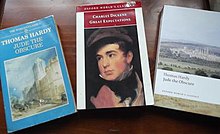Oxford World's Classics



Oxford World's Classics is an imprint of Oxford University Press. First established in 1901 by Grant Richards and purchased by the Oxford University Press in 1906, this imprint publishes primarily dramatic and classic literature for students and the general public. Its competitors include Penguin Classics, Everyman's Library, and the Modern Library. Most titles include critical apparatus - usually, an introduction, bibliography, chronology, and explanatory notes - as is the case with Penguin Classics.[1]
History
Grant Richards
The World's Classics imprint was created by London publisher Grant Richards in 1901.[2] Richards had an 'ambitious publishing programme',[2] and this ambition led to the liquidation of Grant Richards in 1905. Henry Frowde, manager of the Oxford University Press, purchased the series in October 1905.
The Oxford World's Classics were classed as “the most famous works of the English Language”[3] and many volumes contained introductions by distinguished authors, viz. T. S. Eliot and Virginia Woolf, amongst others.[4] The books were marketed as a cheap and accessible series for the general public to read some of the greatest works of literature:
- “Cheaply and in little shelf space, the general reader can build up a library of those books, which, having become part of himself, he wishes now to make a part of his home.”[5]
Design
World's Classics were first published as 'pocket-sized hardbacks'.[4] In response to competition from Penguin, the series was relaunched in paperback format in 1980.[6]To this day, World's Classics are published in paperback, with selected titles in hardback.
Oxford World's Classics
The World's Classics series was relaunched in 1998 as Oxford World's Classics.[7]The new series initially had a dark blue and off-white colour scheme, but this was changed to red and off-white after a lawsuit by Penguin Books USA in 1998, alleging an infringement of their trade dress rights through similarities in design.[6] A decade later, a second relaunch followed with a new design for all titles, which retained the basic colour scheme.[8]
See also
References
- ^ "Oxford World's Classics". Oxford University Press. Oxford University Press.
- ^ a b Louis, William (2013). History of Oxford University Press: Volume III: 1896 to 1970. Oxford University Press. p. 141. ISBN 9780199568406.
- ^ Dust Jacket Leaflet (Robbery Under Arms (1949) Oxford University Press: London).
- ^ a b Oxford World's Classics blurb
- ^ Dust Jacket Leaflet (Rolf, Boldrewood (1949) Robbery Under Arms Oxford University Press: London).
- ^ a b Robbins, Keith, ed. (2017). History of Oxford University Press: Volume IV: 1970 to 2004. Oxford University Press. ISBN 9780192519580.
- ^ Drabble, Margaret (2000). The Oxford Companion to English Literature (6th ed.). Oxford University Press. p. 1117.
- ^ "Relaunching the Oxford World's Classics". OUP Blog.
External links
- European website
- United States website
- "The WORLD'S CLASSICS" and "OXFORD WORLD'S CLASSICS": A Guide to the Clothbound Editions (and Their Variants). Compiled by J. Godsey, Geoffrey Milburn and Nicholas Murray. Draft. Western University, 16 April 2010. Archived here.
- Lise Jaillant,"‘Introductions by Eminent Writers’: T. S. Eliot and Virginia Woolf in the Oxford World’s Classics Series." The Book World: Selling and Distributing Literature, 1900-1940, ed. Nicola Wilson (Leiden: Brill, 2016), pp. 52-80
